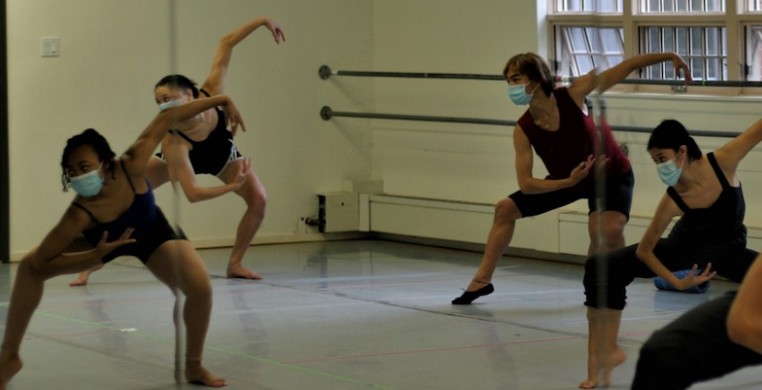The Hyde Park School of Dance (HPSD) has been open on the South Side since 1993, but like most institutions, things look a little different this year. As a non-profit school, HPSD is governed by a board of directors, some of who are doctors at the University of Chicago. The impact of the coronavirus and rumors of the impending shutdown were discussed and the decision was made to close the school on March 14—a few days before an executive order issued by Gov. Pritzker closed all K-12 schools in the state. HPSD had been rehearsing for their upcoming spring performance, so artistic director August Tye immediately began rescheduling. “We thought we were going to be closed for two weeks,” Tye said in a phone interview. “After a few weeks, we saw the writing on the wall and realized we weren’t going to be rescheduling anything.”
Though the performance was cancelled, Tye and team got to work and were set up to resume teaching classes by March 30—of course, using Zoom. Other factors aided in their quick recovery: tuition had already been paid and the majority of families donated their tuition to the school; they received other generous donations, plus grants for things like personal protective equipment (PPE); the board voted to make sure that the staff received their normal pay, uninterrupted; and with Hubbard Street Dance Chicago transitioning to a new space and getting rid of equipment, HPSD picked up a few big screen TVs just in time for summer intensives. “Fiscally, we were really lucky with timing and the generosity of our community,” said Tye. “I want to give a shout out to our board for hanging in there with us artists and not sending us to fend for unemployment. I think it’s better to struggle along and keep the community together than just shut down.”
 HPSD dancers must wear masks, complete a wellness survey and stand in designated spots. Reduced capacity resulted in a sold out summer intensive with about half the number of dancers as last year. Photo by Aislinn McGhee Hassrick
For summer intensives, HPSD decided on a hybrid of Zoom and in-person classes. In addition to masks, social distancing and hand sanitizer, they have a number of other rules (Tye used the model from The Royal Academy of Dance) like coming dressed for class, limited floor work, an initial health survey at the beginning of the workshop and daily health surveys after, and even assigning the students cleaning duties. They also require a liability waiver.
HPSD dancers must wear masks, complete a wellness survey and stand in designated spots. Reduced capacity resulted in a sold out summer intensive with about half the number of dancers as last year. Photo by Aislinn McGhee Hassrick
For summer intensives, HPSD decided on a hybrid of Zoom and in-person classes. In addition to masks, social distancing and hand sanitizer, they have a number of other rules (Tye used the model from The Royal Academy of Dance) like coming dressed for class, limited floor work, an initial health survey at the beginning of the workshop and daily health surveys after, and even assigning the students cleaning duties. They also require a liability waiver.
Did the virus affect enrollment? The first intensive—student choreography—happened so quickly that only a couple of dancers attended, essentially getting private lessons. A four-week intensive program technically sold out although the limitations on space meant about half of the students attended compared to a normal year. “We’re at a break-even-at-best scenario,” said Tye, “but it’s keeping our staff teaching and keeping our community together, keeping our dancers sane. It’s not about making money.”
Teaching by Zoom was a necessary adjustment, but how do you give the same attention to the kids at home? Tye said the teachers try to make it feel like the dancers at home are in the studio, too. The students in the studio are dancing in masks, so they need a lot of breaks. Tye takes that time to focus on the Zoomers. And once the combinations start, she swings the camera around so the students on screen can see the dancers in the studio. “That was a huge challenge, but I really feel passionately about making sure everyone feels included,” Tye said. “We are really listening to our kids and asking for feedback.” When the at-home dancers said they felt they weren’t getting as much feedback and corrections, the teachers took that as a wake-up call. “It’s been a learning experience. Every time we teach, we get better at it.”
So, what motivates Tye to keep going? “Lately it's just pure instinct and following my gut feelings. I know this period of time will pass at some point, but we just don't know when,” she said. “If we can find a way to keep dancing safely then we must try. I have learned being flexible, open to new information and letting planning happen week-to-week is the way it has to be for now. I have learned you cannot satisfy everyone. You have to go with your heart and best instincts that allow you to facilitate the fact that dancers need to dance.”
--
Over the month of August, editor-at-large Vicki Crain profiles four dance institutions to find out where they are in the reopening process and how they are coping with the new guidelines to make sure they are still bringing dance performance and education to the Chicago area.
Did you miss the first piece in this series? Check out Vicki's feature on the Chicago Academy for the Arts.


